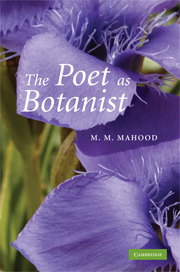Book contents
- Frontmatter
- Contents
- List of illustrations
- Acknowledgements
- A note on quotations
- Introduction
- 1 Primroses at Dove Cottage and Down House
- 2 Erasmus Darwin's feeling for the organism
- 3 Crabbe's slimy mallows and suffocated clover
- 4 John Clare: bard of the wild flowers
- 5 Ruskin's flowers of evil
- 6 D. H. Lawrence, botanist
- 7 Poetry and photosynthesis
- Index of persons
- Index of plants
1 - Primroses at Dove Cottage and Down House
Published online by Cambridge University Press: 22 September 2009
- Frontmatter
- Contents
- List of illustrations
- Acknowledgements
- A note on quotations
- Introduction
- 1 Primroses at Dove Cottage and Down House
- 2 Erasmus Darwin's feeling for the organism
- 3 Crabbe's slimy mallows and suffocated clover
- 4 John Clare: bard of the wild flowers
- 5 Ruskin's flowers of evil
- 6 D. H. Lawrence, botanist
- 7 Poetry and photosynthesis
- Index of persons
- Index of plants
Summary
Primroses grow in some surprising places, thanks to the mice and ants that pick up and then drop their seeds. Soon after Wordsworth and his sister settled in Grasmere, they noticed one on top of a boulder where it (or its progeny) was to remain safely out of human reach for the next thirty years. And as in life, so in literature. In the third part of Modern Painters (1856) a primrose makes a sudden appearance that is inexplicable till we realise where it has come from. The passage affords a good starting point for this study because in it Ruskin is trying to distinguish between the ways in which poets see plants.
So then, we have the three ranks: the man who perceives rightly, because he does not feel, and to whom the primrose is very accurately the primrose, because he does not love it. Then, secondly, the man who perceives wrongly, because he feels, and to whom the primrose is anything else than a primrose: a star, or a sun, or a fairy's shield, or a forsaken maiden. And then, lastly, there is the man who perceives rightly in spite of his feelings, and to whom the primrose is for ever nothing else than itself – a little flower, apprehended in the very plain and leafy fact of it, whatever and how many soever the associations and passions may be that crowd around it. And, in general, these three classes may be rated in comparative order, as the men who are not poets at all, and the poets of the second order, and the poets of the first.
(Modern Painters III, ‘Of Many Things’, chapter 12, § 8)- Type
- Chapter
- Information
- The Poet as Botanist , pp. 7 - 48Publisher: Cambridge University PressPrint publication year: 2008



